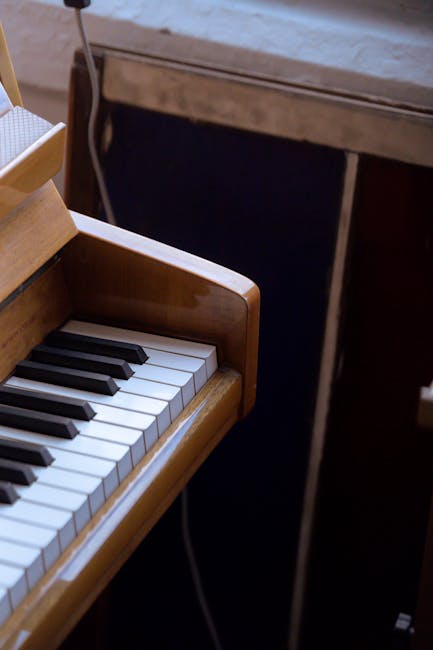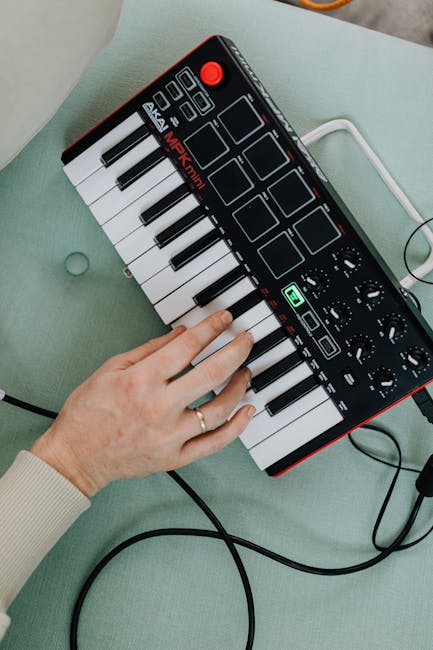Do you ever feel like you’re stuck in a musical rut, playing the same chords over and over again like a broken record? Well, it’s time to break free from the monotony and master chord progressions like a boss! In this article, we’re going to show you some techniques for effortless playing that will have you sounding like a pro in no time. So grab your guitar, piano, or whatever instrument tickles your fancy, and let’s dive into the world of chord progressions!
Contents
- 1 Understanding the Foundations of Chord Progressions
- 2 Exploring Common Progressions Across Genres
- 3 Incorporating Voice Leading for Smooth Transitions
- 4 The Role of Modulation in Enhancing Musical Interest
- 5 Strategies for Memorizing and Practicing Progressions
- 6 Applying Music Theory to Create Unique Progressions
- 7 Overcoming Common Challenges in Chord Transition Mastery
- 8 FAQs
- 9 Now go forth and conquer those chords!
Understanding the Foundations of Chord Progressions
Alright, let’s dive into the magical world of chord progressions! Get ready to learn the secrets behind those catchy tunes that make you tap your foot and sing along.
First off, **major and minor chords** are like the peanut butter and jelly of music. They’re the building blocks of chord progressions and can evoke different emotions depending on how they’re used. Just like how peanut butter and jelly can make a delicious sandwich or a messy disaster if not used correctly.
Next up, we have the **I-IV-V chord progression**. It’s like the holy trinity of chord progressions in music. It’s guaranteed to get your head nodding and your hips swaying. It’s like the perfect recipe for a hit song, just add in some catchy lyrics and a killer beat.
And let’s not forget about **secondary dominants**. These bad boys add some spicy flavor to your chord progressions. They’re like the hot sauce of music – a little goes a long way, but too much can leave your ears burning.

Exploring Common Progressions Across Genres
When it comes to music, there are certain chord progressions that seem to pop up time and time again, no matter what genre you’re listening to. It’s like the universe’s way of reminding us that hey, we’re all connected through the power of music!
Whether you’re rocking out to some classic rock, grooving to a funky jazz fusion band, or getting down to some hip-hop beats, you’ll likely come across these common progressions:
- I-IV-V: The holy trinity of chord progressions. It’s simple, it’s catchy, and it’s been used in everything from pop to punk to polka.
- ii-V-I: The jazz standard. If you want to sound sophisticated and hip, just throw in a ii-V-I progression and watch your audience nod approvingly.
- vi-IV-I-V: The emotional rollercoaster. This progression is like a musical representation of a breakup and makeup all in one.
So next time you’re listening to your favorite tunes, see if you can pick out these common progressions. It’s like a musical scavenger hunt that will have you feeling like a music theory detective in no time!

Incorporating Voice Leading for Smooth Transitions
So you want your music to flow like a gentle stream, eh? Well, incorporating voice leading is the key to achieving those smooth transitions that will make your listeners go, “Whoa, that was slick!” Imagine your music as a well-orchestrated dance, with each instrument gracefully handing off the melody to the next. It’s all about guiding your harmonies and melodies in a way that keeps everything sounding cohesive and connected.
One trick to master voice leading is to pay attention to the intervals between your notes. Think of each note as a character in a story – they should move in a way that makes sense and feels natural. Avoiding jarring leaps and instead opting for stepwise motion will help create a seamless journey through your music.
Another handy tool in your voice leading toolbox is chord inversions. Playing around with different inversions can help smooth out the transitions between chords, giving your music that extra touch of finesse. Plus, experimenting with inversions can lead to some really interesting and unexpected harmonic twists and turns that will keep your listeners on their toes.
Remember, incorporating voice leading isn’t just about following rules - it’s about using your ear and intuition to guide your musical choices. So go forth, dear musician, and let your melodies glide effortlessly from one note to the next. Your music will thank you for it!

The Role of Modulation in Enhancing Musical Interest
Have you ever listened to a song and thought, “Wow, this is getting a little repetitive”? That’s where modulation comes in to save the day! With modulation, musicians can spice up their tunes and keep listeners on their toes.
One of the coolest things about modulation is that it can completely change the mood of a song. Let’s say you’re listening to a sweet, innocent love ballad and all of a sudden, BAM! The music shifts to a minor key and you’re left feeling like you’re in a haunted house. Talk about a plot twist!
Modulation can also add a touch of sophistication to a piece of music. It’s like putting on a fancy hat or a bow tie – suddenly, you’re all dressed up and ready to impress. Musicians use modulation to show off their musical prowess and keep audiences engaged.
So next time you’re jamming out to your favorite song, pay attention to those sneaky modulations. They might just be the secret ingredient that’s keeping you hooked and tapping your foot along.

Strategies for Memorizing and Practicing Progressions
So you’ve decided to tackle memorizing and practicing progressions, huh? Well, get ready for a wild ride filled with highs and lows, cheers and tears! But fear not, I’ve got some strategies that will make this journey a little less bumpy (and a lot more fun).
First things first, repetition is key. Just like practicing anything else, the more you repeat those progressions, the more they’ll stick in your brain. It’s like trying to remember your high school crush’s phone number – you just gotta keep dialing it in until it’s permanently etched in your memory (or until they change it).
Another great strategy is to break down the progression into smaller chunks. Think of it like eating a giant pizza – you wouldn’t try to shove the whole thing in your mouth at once (or maybe you would, I don’t know your life), you’d take it one slice at a time. So tackle those progressions in manageable chunks and soon enough, you’ll have the whole pie memorized!
And last but not least, don’t forget to mix things up a bit. Practice those progressions in different keys, tempos, or even styles. It’s like giving your brain a little workout – you wouldn’t just do squats at the gym all day, would you? (Well, maybe you would, but that’s beside the point). So mix it up and keep things interesting!
Applying Music Theory to Create Unique Progressions
Are you tired of using the same basic chord progressions in your music? Want to spice things up and create some truly unique sounds? Well, look no further than applying music theory to your compositions!
By utilizing the principles of music theory, you can create progressions that will make your listeners sit up and take notice. Forget about your standard I-IV-V progressions – let’s venture into uncharted territory!
Here are a few tips to get you started on your journey to creating one-of-a-kind chord progressions:
- Experiment with modal interchange: Mix and match chords from different modes to create unexpected tonalities.
- Try out some non-diatonic chords: Don’t be afraid to throw in a chord that doesn’t quite fit the key – it can add some interesting tension to your progression.
- Play around with inversions: Changing the order in which you play your chords can completely transform the feel of your progression.
Overcoming Common Challenges in Chord Transition Mastery
Transitioning between chords can be a tricky task for many budding musicians. But fear not, you are not alone in your struggles! Here are some common challenges you may face when trying to master chord transitions, and some creative solutions on how to overcome them:
- **Finger gymnastics:** Trying to contort your fingers into strange shapes on the fretboard can feel like doing yoga for your hands. To combat this, try practicing finger exercises to improve dexterity and flexibility. Remember, Rome wasn’t built in a day, and neither were perfectly executed Fmaj7 chords.
- **Slow motion transitions:** It’s like watching a sloth race trying to switch between chords at a glacial pace. Speed up your transitions by practicing with a metronome to keep you on beat. You’ll be zooming through chord changes like a racecar driver in no time.
- **The phantom fifth finger:** It seems to have a mind of its own, never quite landing where it’s supposed to. Make sure to place each finger on the correct string and fret with intention, rather than relying on some mystical sixth sense. Engage that fifth finger like you’re giving it a motivational pep talk.
Remember, mastering chord transitions takes time and patience. Don’t get discouraged by the challenges along the way. Embrace the process, keep practicing, and soon enough you’ll be smoothly transitioning between chords like a rockstar.
FAQs
What are the common chord progressions used in music?
Oh, dear reader, there are so many chord progressions out there! Classics like the I-IV-V and the ii-V-I are always crowd-pleasers. But don’t forget about the beloved jazz progression of the ii7-V7-I, or the soulful vi-IV-I-V. The possibilities are endless!
How can I remember all these different chord progressions?
Ah, the age-old question! The key is practice, my friend. Repetition is your best friend here. Try playing these progressions in different keys, at different tempos, and in different styles. Soon enough, your fingers will know the way without even having to think about it.
What are some tips for transitioning smoothly between chord progressions?
Aha! The secret to smooth transitions lies in your fingertips. Make sure you know the shapes of the chords like the back of your hand. Practice shifting between chords slowly at first, then gradually speed up. And don’t forget to keep your strumming hand moving in a steady rhythm to keep the flow going.
How can I spice up my chord progressions to make them more interesting?
Oh, I love a good spicy chord progression! Try adding in some unexpected chords, like a borrowed chord or a secondary dominant. Experiment with inversions and voicings to create a richer sound. And don’t be afraid to throw in some rhythmic variation to keep things exciting!
Any final words of advice for mastering chord progressions?
Ah, my dear reader, the journey to mastering chord progressions is a never-ending one. Embrace the challenge, practice with passion, and don’t be afraid to make mistakes along the way. Remember, it’s not about perfection; it’s about the joy of making music. Now go forth and conquer those chords, my musical warrior!
Now go forth and conquer those chords!
You’ve armed yourself with the knowledge and techniques to become a chord progression master. So go ahead, pick up your guitar or sit down at the piano and start practicing. And remember, even the greatest musicians started off as beginners. So don’t get discouraged if you struggle at first. With time, patience, and a little bit of practice, you’ll be effortlessly strumming or playing your way through any chord progression in no time. So go out there and make some beautiful music!



